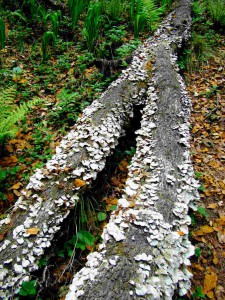
Trametes versicolor
Trametes versicolor, commonly known as Turkey Tail, is a striking polypore mushroom found in the rich forest ecosystems of the Great Himalayan National Park (GHNP). Named for its vividly banded, fan-like shape resembling a wild turkey’s tail, this fungus is both ecologically important and medicinally renowned.
Habitat and Identification
Trametes versicolor grows on dead hardwood logs, stumps, and fallen branches, thriving in the moist, temperate forests of GHNP. It typically appears in layered clusters, with concentric rings of varying colors such as brown, gray, white, and blue. The underside of the cap features tiny pores, distinguishing it from look-alike fungi.
In GHNP, it’s often found in mixed oak and coniferous forests, where decaying organic matter supports a diverse fungal community.
Ecological Role
This mushroom is a saprobic decomposer, playing a critical role in breaking down lignin and cellulose in dead wood. By accelerating wood decay, Trametes versicolor helps recycle nutrients, thereby maintaining forest soil health and promoting new plant growth. Its presence indicates a thriving, balanced forest ecosystem.
Medicinal Significance
Trametes versicolor is globally celebrated in traditional and modern medicine for its immunomodulatory properties. It contains polysaccharide-K (PSK) and polysaccharide-peptide (PSP), compounds known to stimulate the immune system and are used in cancer therapy, particularly in Asia.
Local communities near GHNP also recognize its value in traditional herbal remedies, although its use is less commercialized than other medicinal mushrooms.
Conservation and Research
Though not endangered, Trametes versicolor benefits from GHNP’s conservation policies, which protect forest integrity and reduce overharvesting. Scientific interest in its bioactive compounds has increased, encouraging fungal biodiversity monitoring in protected areas like GHNP.
Conclusion
Trametes versicolor is more than a beautiful forest mushroom—it is a keystone decomposer and a promising natural medicine. Its presence in the Great Himalayan National Park highlights the richness of the region’s fungal diversity. Conserving its habitat ensures the continued health of the forest and the potential for future discoveries in ecology and medicine.



